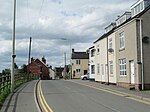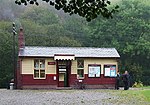Kingsley and Froghall railway station
1849 establishments in EnglandBeeching closures in EnglandFormer North Staffordshire Railway stationsHeritage railway stations in StaffordshirePages with no open date in Infobox station ... and 4 more
Railway stations in Great Britain closed in 1965Railway stations in Great Britain opened in 1849Railway stations in Great Britain opened in 2001Use British English from September 2022
Kingsley and Froghall is a former railway station of the North Staffordshire Railway (NSR) that is now preserved on the Churnet Valley Railway in Staffordshire, England.
Excerpt from the Wikipedia article Kingsley and Froghall railway station (License: CC BY-SA 3.0, Authors).Kingsley and Froghall railway station
Brookside, Staffordshire Moorlands
Geographical coordinates (GPS) Address Nearby Places Show on map
Geographical coordinates (GPS)
| Latitude | Longitude |
|---|---|
| N 53.0208 ° | E -1.964 ° |
Address
Churnet Valley Railway Car Park
Brookside
ST10 2HE Staffordshire Moorlands
England, United Kingdom
Open on Google Maps







